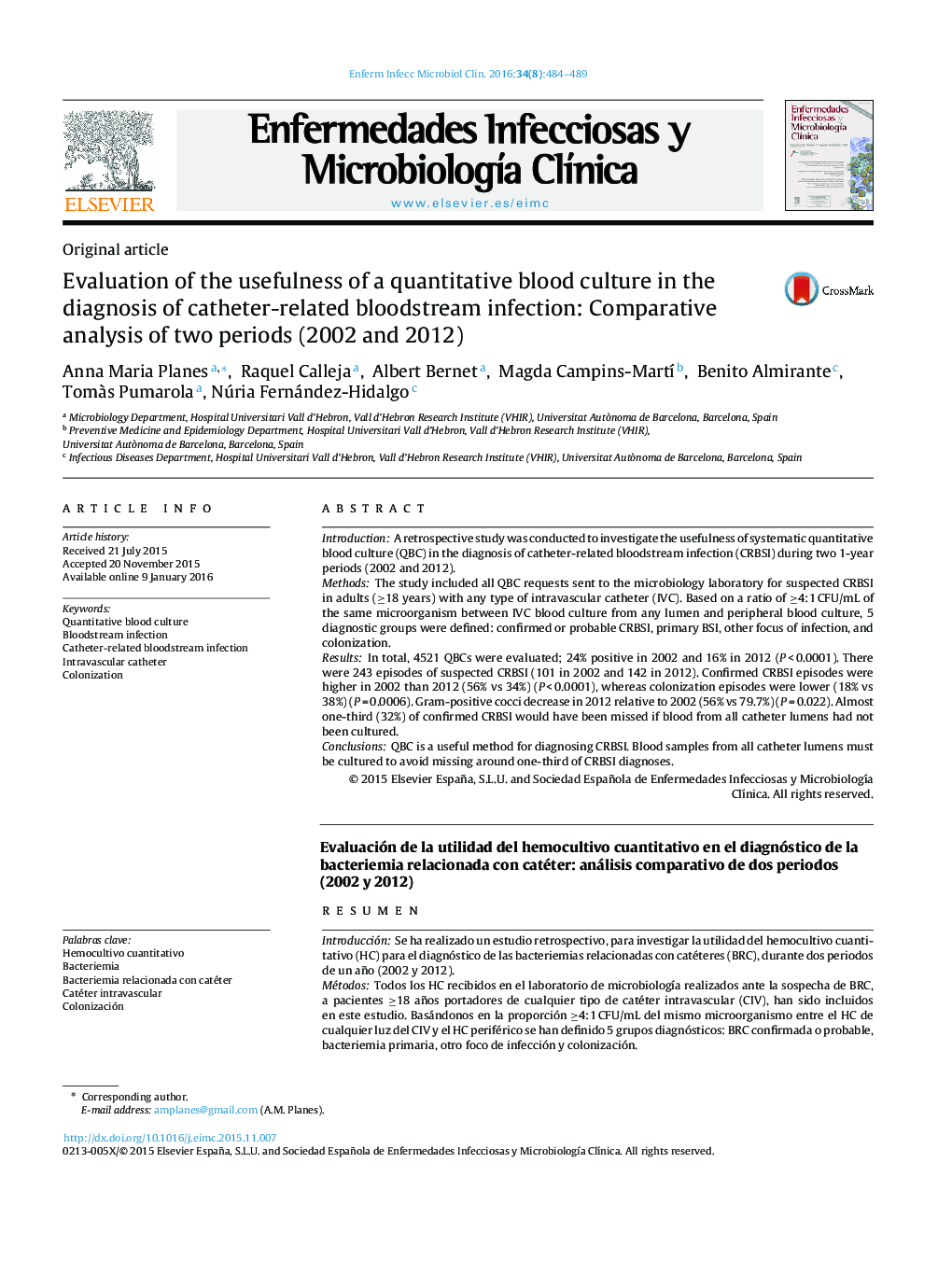| کد مقاله | کد نشریه | سال انتشار | مقاله انگلیسی | نسخه تمام متن |
|---|---|---|---|---|
| 3400487 | 1408088 | 2016 | 6 صفحه PDF | دانلود رایگان |
IntroductionA retrospective study was conducted to investigate the usefulness of systematic quantitative blood culture (QBC) in the diagnosis of catheter-related bloodstream infection (CRBSI) during two 1-year periods (2002 and 2012).MethodsThe study included all QBC requests sent to the microbiology laboratory for suspected CRBSI in adults (≥18 years) with any type of intravascular catheter (IVC). Based on a ratio of ≥4:1 CFU/mL of the same microorganism between IVC blood culture from any lumen and peripheral blood culture, 5 diagnostic groups were defined: confirmed or probable CRBSI, primary BSI, other focus of infection, and colonization.ResultsIn total, 4521 QBCs were evaluated; 24% positive in 2002 and 16% in 2012 (P < 0.0001). There were 243 episodes of suspected CRBSI (101 in 2002 and 142 in 2012). Confirmed CRBSI episodes were higher in 2002 than 2012 (56% vs 34%) (P < 0.0001), whereas colonization episodes were lower (18% vs 38%) (P = 0.0006). Gram-positive cocci decrease in 2012 relative to 2002 (56% vs 79.7%) (P = 0.022). Almost one-third (32%) of confirmed CRBSI would have been missed if blood from all catheter lumens had not been cultured.ConclusionsQBC is a useful method for diagnosing CRBSI. Blood samples from all catheter lumens must be cultured to avoid missing around one-third of CRBSI diagnoses.
ResumenIntroducciónSe ha realizado un estudio retrospectivo, para investigar la utilidad del hemocultivo cuantitativo (HC) para el diagnóstico de las bacteriemias relacionadas con catéteres (BRC), durante dos periodos de un año (2002 y 2012).MétodosTodos los HC recibidos en el laboratorio de microbiología realizados ante la sospecha de BRC, a pacientes ≥18 años portadores de cualquier tipo de catéter intravascular (CIV), han sido incluidos en este estudio. Basándonos en la proporción ≥4:1 CFU/mL del mismo microorganismo entre el HC de cualquier luz del CIV y el HC periférico se han definido 5 grupos diagnósticos: BRC confirmada o probable, bacteriemia primaria, otro foco de infección y colonización.ResultadosHan sido evaluados 4521 HC; 24% positivos en 2002 y 16% en 2012 (P < 0.0001). Fueron sospechosos de BRC 243 episodios (101 en 2002 y 142 en 2012). El Porcentaje de episodios de BRC confirmados fue mayor en 2002 que en 2012 (56% vs 34%) (P < 0.0001), en cambio fue menor el de los episodios de colonización (18% vs 38%) (P = 0.0006). Los cocos Gram-positivos disminuyeron en 2012 en relación con 2002 (56% vs 79.7%) (P = 0.022). En el 32.2% de las BRC confirmadas se hubiese perdido el diagnóstico si no se hubiera realizado HC de todas las luces.ConclusionesEl HC es un método muy útil para el diagnóstico de las BRC. Hay que obtener muestra de sangre de todas luces para cultivo con el fin de evitar la pérdida de alrededor del 30% de los episodios de BRC.
Journal: Enfermedades Infecciosas y Microbiología Clínica - Volume 34, Issue 8, October 2016, Pages 484–489
